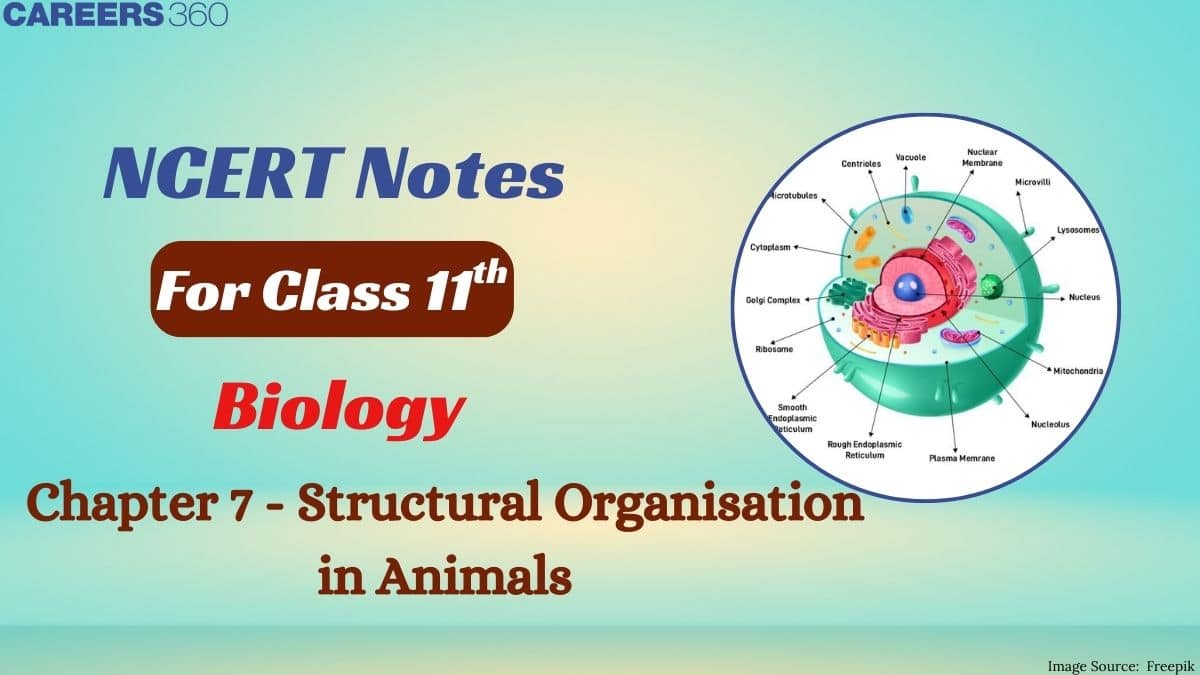Class 11 Biology Chapter 7 Structural Organisation In Animals Notes
The notes explain how different types of cells, tissues, and organs are organized in animals. Important systems like the digestive, respiratory, and reproductive structures in animals such as frogs are discussed in a simple way. The content of the Structural Organisation in Animals Class 11 Notes is prepared by the subject experts following the latest NCERT guidelines. Important terms and definitions are highlighted to make revision quick and effective.
Organ and Organ System
The tissues of two or more types combine to form an organ. An organ is an organised part of the body that performs one or more special functions. Several organs combine for a common function to constitute an organ system.
The external and internal features of the frog are mentioned below.
Frog
Frogs are amphibians that live both on land and in water. They have smooth and moist skin. These are cold-blooded animals and undergo metamorphosis. The morphology and anatomy of frogs are well-described in the notes given below, along with well-labeled diagrams to gain a clear understanding.
Morphology
The morphology of a frog includes its external structure and body shape. A frog has smooth, moist skin that is usually green or brown, allowing it to blend with its surroundings. Its body is divided into the head and trunk. Frogs have large eyes and a pair of nostrils. Frogs have strong hind limbs that are longer than the front limbs, which help them jump long distances and swim effectively.
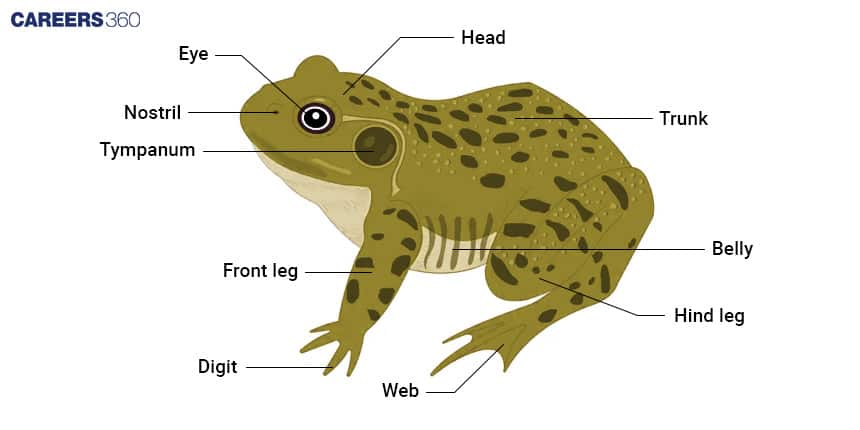
Anatomy
The anatomy of a frog includes various systems that help it survive in both land and water. The respiratory system allows frogs to breathe through their lungs on land and through their moist skin in water.
Circulatory System of the Frog
In frogs, the circulatory system is well-developed and consists of a three-chambered heart, two atria, and one ventricle. This heart pumps blood both to the lungs for oxygenation and to the rest of the body. Frogs have a double circulation system, which means blood passes through the heart twice during one complete cycle. This helps in efficiently transporting oxygen and nutrients throughout the body.
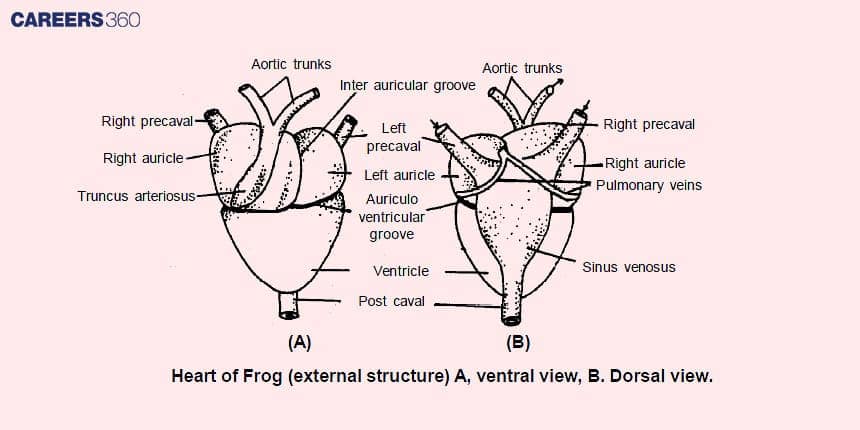
Nervous System of the Frog
The nervous system includes the brain and spinal cord, as well as cranial and spinal nerves, which control movement and responses. The sensory organs include the organs of touch, hearing, smell, vision, and taste. It helps the frog respond quickly to its surroundings and coordinate body activities. The brain is divided into the forebrain, midbrain, and hindbrain, each with specific functions. Together, the nervous system and sense organs play a key role in survival and behavior.
Reproductive System of the Frog
The male reproductive system consists of a pair of testes above the kidneys, vasa efferentia, and the canal. The female reproductive system includes the ovaries and oviducts. It undergoes external fertilisation and indirect development. The well-labeled diagram of the reproductive system of a frog is given below.
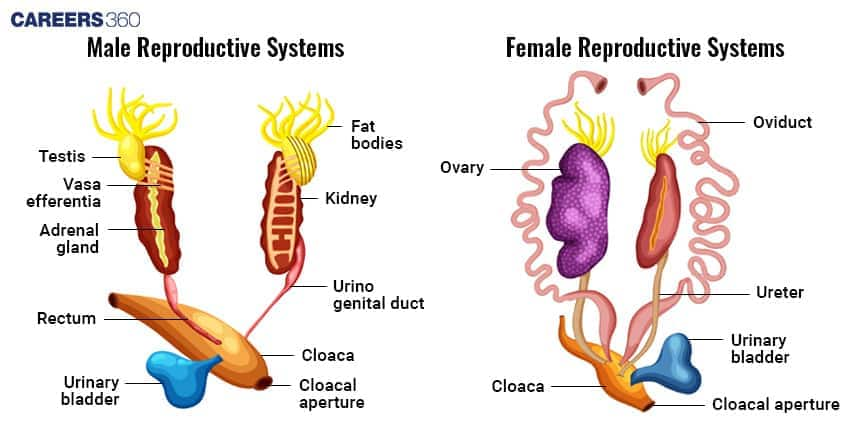
Digestive System of the Frog
The digestive system of a frog consists of a short alimentary canal, digestive glands, mouth, tongue, buccal cavity, oesophagus, pharynx, stomach, intestine, and cloaca. Food is digested with the help of digestive juices secreted by the liver and pancreas. The undigested waste passes through the cloaca and is finally removed from the body.
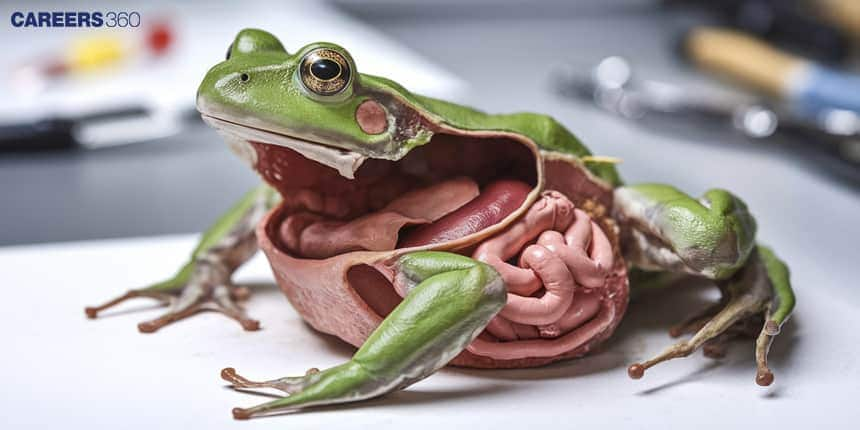
Excretory System of the Frog
The excretory system of a frog includes a pair of kidneys that help in removing waste from the body. Each kidney is connected to a ureter, which carries the waste in the form of urine to the cloaca. In males, the ureter also carries sperm. The urinary bladder stores urine before it is passed out through the cloacal aperture. The cloaca is a common chamber for the excretory, digestive, and reproductive systems.
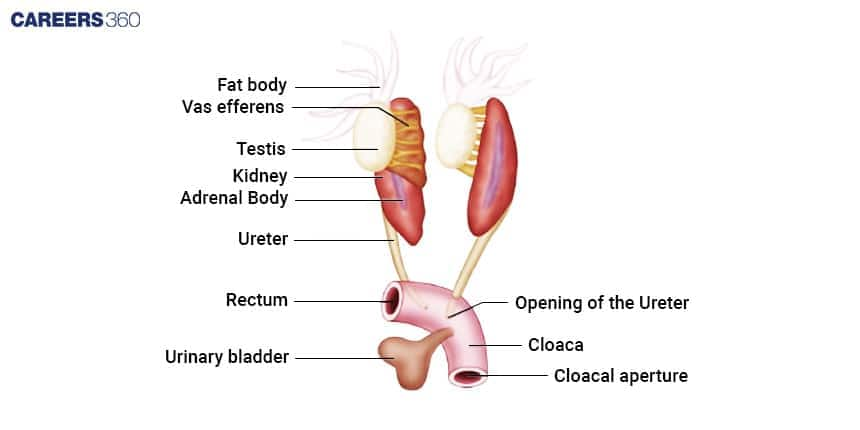
Also, Read
Structural Organisation in Animals: Previous Year Questions and Answers
Below are a few previous year questions from this chapter to help students get familiar with the pattern and difficulty level. Students can go through the NCERT Class 11 Biology Chapter 7 Notes Structural Organisation in Animals before attempting the questions.
Question 1. Choose the accurate route for the passage of sperm in the male frog:
Option 1. Testes → Vasa efferentia → Kidney →Seminal vesicle →Urinogenital duct → Cloaca
Option 2. Testes → Vasa efferentia → Bidder's canal → Ureter → Cloaca
Option 3. Testes → Vasa efferentia → Kidney → Bider's canal → Urinogenital duct → Cloaca
Option 4. Testes → Bider's canal → Kidney → Vasa efferentia → Urinogenital duct → Cloaca
Answer :
In male frogs, the sperm follow a specific route during their passage for reproduction. The process starts with the sperm being produced in the testes. From there, they travel through the vasa efferentia, which are tiny ducts that connect the testes to the kidney. Once in the kidney, the sperm moves into the Bider's canal. From the Bider's canal, the sperm then enter the urinogenital duct, which is responsible for carrying both urine and reproductive fluids. Finally, the sperm reaches its destination, the cloaca.
Hence, the correct answer is option (3), Testes → Vasa efferentia → Kidney → Bider's canal → Urinogenital duct → Cloaca
Question 2. Which of the following best describes the breathing mechanism in frogs?
Option 1. Diaphragmatic breathing
Option 2. Costal breathing
Option 3. Buccal pumping
Option 4. Pharyngeal pumping
Answer:
Buccal pumping is the breathing mechanism observed in frogs. It involves the rhythmic movement of the floor of the oral cavity, or buccal cavity, to facilitate respiration. In frogs, buccal pumping involves the coordinated action of the muscles in the buccal cavity, which leads to the inhalation and exhalation of air. As the floor of the buccal cavity moves down, fresh air is drawn in through the nostrils. When the floor moves up, the air is forced out of the lungs and through the nostrils.
Hence, the correct answer is option (3), Buccal pumping
Question 3. What role does the glottis play in frog respiration?
Option 1. It allows for the entry of air into the lungs.
Option 2. It controls the opening and closing of the nostrils.
Option 3. It aids in vocalization and sound production.
Option 4. It helps in the regulation of body temperature.
Answer:
The glottis is a small opening located at the back of the oral cavity in frogs. It serves as the entrance to the respiratory system. When a frog breathes, the glottis opens, allowing air to enter the lungs. This air passes through the buccal cavity, where gas exchange occurs across the moist lining, and then continues into the lungs for further gas exchange. After oxygen is extracted from the air in the lungs, carbon dioxide is expelled from the body through the same pathway.
Hence, the correct answer is option (1), It allows for the entry of air into the lungs.
Question 4. In earthworms, the clitellum is associated with:
Option 1. Locomotion
Option 2. Reproduction
Option 3. Respiration
Option 4. Excretion
Answer:
The clitellum is a thick, glandular, and non-segmental structure found in sexually mature earthworms. It secretes mucus and albuminous fluid to form the cocoon, where fertilisation and development occur. Thus, it plays a crucial role in the reproductive process.
Hence, the correct answer is option (2) Reproduction
Question 5. In the cockroach, which structure is responsible for excretion?
Option 1. Nephridia
Option 2. Malpighian tubules
Option 3. Green glands
Option 4. Coxal glands
Answer:
Cockroaches possess Malpighian tubules, fine thread-like structures that float freely in the hemocoel. These tubules absorb nitrogenous wastes from the hemolymph and help excrete them as uric acid, making cockroaches uricotelic.
Hence, the correct answer is option (2) Malpighian tubules
Also Read:
